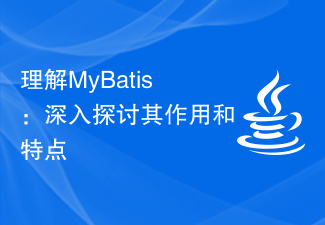 Java
Java javaTutorial
javaTutorial Discussion on methods and techniques for authenticating official seals in Java development
Discussion on methods and techniques for authenticating official seals in Java development
Discussion on methods and techniques for identifying the authenticity of official seals in Java development
In Java development, identifying the authenticity of official seals is an important task. When we perform operations such as data transmission, interface calls, or file exchanges, we often need to use official seals to verify the legality and authenticity of the data. Therefore, accurately identifying the authenticity of an official seal is a basic task to ensure data security and transaction reliability. This article will discuss the methods and techniques of authenticating official seals in Java development, and provide code examples for reference.
1. Methods for authenticating official seals
In Java development, we often use the digital signature mechanism to verify the authenticity of official seals. The digital signature mechanism uses the principle of public key cryptography. By encrypting the data and the private key, an encrypted digest is generated, and then the encrypted digest is transmitted to the other party together with the original data. The other party uses the public key after receiving the data. Decrypt to get the digest, then generate your own digest by hashing the original data, and compare the two. If the two are consistent, it means that the data has not been tampered with and the verification has passed; if they are inconsistent, it means that the data has been tampered with and the verification has failed.
The specific authentication method of official seal authenticity is as follows:
- Generate a public and private key pair: First, you need to generate a public and private key pair, where the private key is used to encrypt data, and the public key Used to decrypt data.
- Data encryption: Encrypt the original data, use the private key to encrypt the data, and generate an encrypted digest.
- Data transmission: Transmit the encrypted digest together with the original data to the other party.
- Data decryption and identification: After receiving the data, the other party uses the public key to decrypt the digest, then generates its own digest by hashing the original data, and compares the two. If the two are consistent, it means that the data has not been tampered with and the verification has passed; if they are inconsistent, it means that the data has been tampered with and the verification has failed.
2. Tips for authenticating official seals
- Key management: When authenticating official seals, key management is a very critical task. The private key should be kept properly to avoid being obtained by others; the public key can be used publicly, but the accuracy of the public key needs to be ensured.
- Selection of digest algorithm: In the process of data encryption and decryption, it is necessary to select an appropriate digest algorithm. Commonly used digest algorithms include MD5, SHA-1, SHA-256, etc. Choose the appropriate algorithm for encryption and decryption according to your needs.
- Data integrity protection: The purpose of authenticating the official seal is to protect the integrity of the data. Therefore, before authenticating the official seal, it is necessary to ensure the integrity of the data. Digital signatures or hashing algorithms can be used to protect data integrity.
3. Code examples for authenticating official seals
The following is a simple example of using Java to authenticate official seals:
import java.security.KeyPair;
import java.security.KeyPairGenerator;
import java.security.PrivateKey;
import java.security.PublicKey;
import java.security.Signature;
public class SignatureExample {
public static void main(String[] args) throws Exception {
// 生成公私钥对
KeyPairGenerator keyPairGenerator = KeyPairGenerator.getInstance("RSA");
KeyPair keyPair = keyPairGenerator.generateKeyPair();
PublicKey publicKey = keyPair.getPublic();
PrivateKey privateKey = keyPair.getPrivate();
// 原始数据
String originalData = "Hello, world!";
// 数据签名
Signature signature = Signature.getInstance("SHA256withRSA");
signature.initSign(privateKey);
signature.update(originalData.getBytes());
byte[] signatureBytes = signature.sign();
// 数据验证
Signature signature2 = Signature.getInstance("SHA256withRSA");
signature2.initVerify(publicKey);
signature2.update(originalData.getBytes());
boolean isValid = signature2.verify(signatureBytes);
// 输出结果
System.out.println("Original data: " + originalData);
System.out.println("Signature: " + new String(signatureBytes));
System.out.println("Is valid: " + isValid);
}
}The above code examples demonstrate How to use the RSA algorithm to generate a public-private key pair, and use the SHA256withRSA algorithm for data signing and verification. Algorithms and data can be modified as needed for testing.
Summary:
In Java development, identifying the authenticity of official seals is an important task. This article discusses the methods and techniques of using the digital signature mechanism to identify the authenticity of official seals, and provides code examples for reference. It is hoped that readers can understand and use official seal authenticity identification technology through this article to improve data security and transaction reliability.
The above is the detailed content of Discussion on methods and techniques for authenticating official seals in Java development. For more information, please follow other related articles on the PHP Chinese website!
 深入探讨:Django框架是什么?Jan 19, 2024 am 09:23 AM
深入探讨:Django框架是什么?Jan 19, 2024 am 09:23 AMDjango框架是一种用于Web应用程序的Python框架,它提供了一个简单而强大的方式来创建Web应用程序。事实上,Django已经成为当前最受欢迎的PythonWeb开发框架之一,也成为很多公司的首选,包括Instagram和Pinterest。本文将深入探讨Django框架是什么,包括基础概念和重要组件,以及具体代码示例。Django基础概念Djan
 深入探讨Laravel中的Head请求方法Mar 06, 2024 pm 03:36 PM
深入探讨Laravel中的Head请求方法Mar 06, 2024 pm 03:36 PM作为一个流行的PHP框架,Laravel提供了许多便捷的请求方法来处理不同类型的HTTP请求。其中,Head请求方法是一个比较特殊且常被忽视的方法。在本文中,我们将深入探讨Laravel中Head请求方法的作用、用法和示例代码。什么是Head请求方法?Head请求方法是HTTP协议中定义的一种请求方法,在发送Head请求时,服务器将仅返回请求头信息,而不会返
 深入探讨Go语言对C语言的兼容程度Mar 07, 2024 pm 02:45 PM
深入探讨Go语言对C语言的兼容程度Mar 07, 2024 pm 02:45 PMGo语言是一门由Google开发的编程语言,具有高效、简洁、并发性强等特点。它在语法结构、包管理、高级特性等方面都有很大的优势,因此备受程序员青睐。然而,在实际开发中,很多项目会涉及到与传统的编程语言C进行交互,因此Go语言与C语言的兼容性就显得尤为重要。首先,我们来谈谈Go语言与C语言的兼容性。在Go语言中,可以通过CGo将Go语言与C语言进行交互。CGo
 深入探讨:Go语言中的单线程特性Mar 15, 2024 pm 02:09 PM
深入探讨:Go语言中的单线程特性Mar 15, 2024 pm 02:09 PMGo语言作为一种现代化的编程语言,以其简洁高效的特性在近年来受到越来越多开发者的喜爱和青睐。其中一个让人独特的地方就是其单线程特性。在传统的多线程编程语言中,开发者通常需要手动管理线程之间的同步和互斥,而在Go语言中,借助其独特的协程(Goroutine)和通信机制(channel),可以方便且高效地实现并发编程。一、Goroutine与单线程:Go语言中的
 深入探讨:Golang是否适合编写驱动程序?Mar 20, 2024 am 10:09 AM
深入探讨:Golang是否适合编写驱动程序?Mar 20, 2024 am 10:09 AMGolang是一种由谷歌开发的编程语言,其出色的性能和并发特性使其在各种领域中得到了广泛的应用,包括网络编程、大数据处理等。然而,对于一些需要直接操作硬件的领域,比如驱动程序开发,人们可能会开始思考:Golang是否适合用于编写驱动程序呢?本文将深入探讨这个问题,并通过具体的代码示例来展示Golang在驱动程序开发中的应用。首先,让我们来了解一下什么是驱动程
 深入探讨Linux中常见的特殊字符Mar 14, 2024 pm 02:54 PM
深入探讨Linux中常见的特殊字符Mar 14, 2024 pm 02:54 PMLinux操作系统作为一种常用的开源操作系统,具有强大的可定制性和灵活性。在使用Linux系统时,我们经常会遇到各种特殊字符的处理。这些特殊字符在命令行中具有特殊的含义,能够实现很多高级功能。本文将深入探讨Linux中常见的特殊字符,并结合具体的代码示例来详细介绍它们的用法。通配符:通配符是用来匹配文件名的特殊字符,常见的通配符包括*、?、[]等。下面是几种
 理解MyBatis:深入探讨其作用和特点Feb 22, 2024 pm 03:48 PM
理解MyBatis:深入探讨其作用和特点Feb 22, 2024 pm 03:48 PMMyBatis(又称为iBatis)是一个流行的Java持久层框架,其设计理念是以SQL为核心,在实现SQL和Java对象的映射过程中提供了方便灵活的操作接口。MyBatis通过XML或注解方式配置SQL语句,并提供了丰富的查询方式,使得开发者可以更加直观地编写数据库操作的代码。本文将深入探讨MyBatis的作用和特点,以及提供具体的代码示例加以说明。作用和
 Golang的本质是脚本语言还是编译语言?探讨Mar 19, 2024 pm 03:12 PM
Golang的本质是脚本语言还是编译语言?探讨Mar 19, 2024 pm 03:12 PMGolang的本质是脚本语言还是编译语言?探讨Golang,也被称为Go语言,是一种由Google开发的静态类型编程语言。自诞生以来,Golang一直备受开发者关注,其优秀的并发性能、简洁的语法和跨平台特性使其在各个领域得到广泛应用。然而,关于Golang到底是脚本语言还是编译语言,却一直存在着争议。脚本语言和编译语言在运行时的不同方式给人们留下了深刻的印象


Hot AI Tools

Undresser.AI Undress
AI-powered app for creating realistic nude photos

AI Clothes Remover
Online AI tool for removing clothes from photos.

Undress AI Tool
Undress images for free

Clothoff.io
AI clothes remover

AI Hentai Generator
Generate AI Hentai for free.

Hot Article

Hot Tools

Zend Studio 13.0.1
Powerful PHP integrated development environment

mPDF
mPDF is a PHP library that can generate PDF files from UTF-8 encoded HTML. The original author, Ian Back, wrote mPDF to output PDF files "on the fly" from his website and handle different languages. It is slower than original scripts like HTML2FPDF and produces larger files when using Unicode fonts, but supports CSS styles etc. and has a lot of enhancements. Supports almost all languages, including RTL (Arabic and Hebrew) and CJK (Chinese, Japanese and Korean). Supports nested block-level elements (such as P, DIV),

Notepad++7.3.1
Easy-to-use and free code editor

ZendStudio 13.5.1 Mac
Powerful PHP integrated development environment

VSCode Windows 64-bit Download
A free and powerful IDE editor launched by Microsoft





